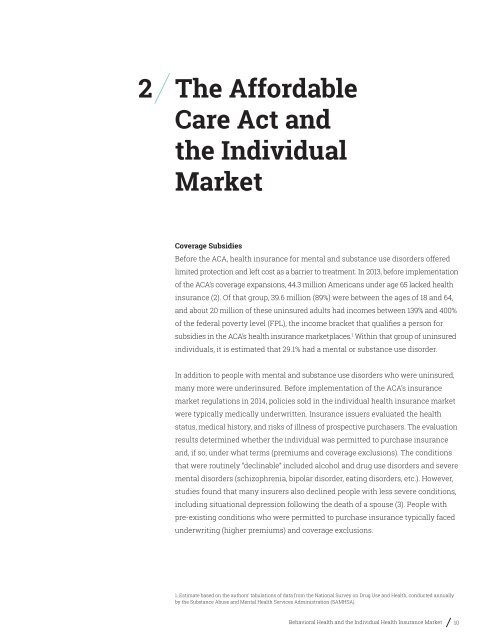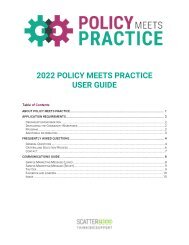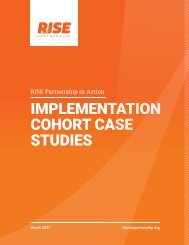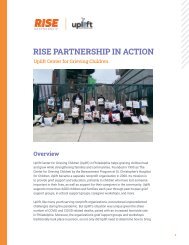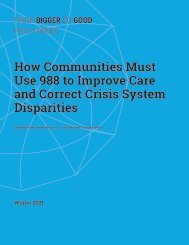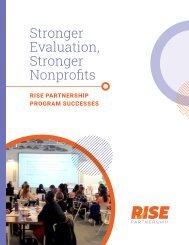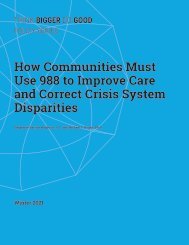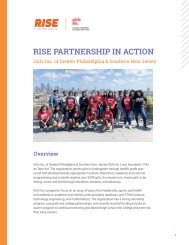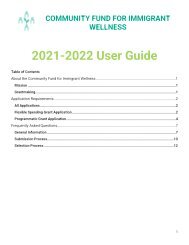Behavioral Health and the Individual Health Insurance Market
You also want an ePaper? Increase the reach of your titles
YUMPU automatically turns print PDFs into web optimized ePapers that Google loves.
2<br />
The Affordable<br />
Care Act <strong>and</strong><br />
<strong>the</strong> <strong>Individual</strong><br />
<strong>Market</strong><br />
Coverage Subsidies<br />
Before <strong>the</strong> ACA, health insurance for mental <strong>and</strong> substance use disorders offered<br />
limited protection <strong>and</strong> left cost as a barrier to treatment. In 2013, before implementation<br />
of <strong>the</strong> ACA’s coverage expansions, 44.3 million Americans under age 65 lacked health<br />
insurance (2). Of that group, 39.6 million (89%) were between <strong>the</strong> ages of 18 <strong>and</strong> 64,<br />
<strong>and</strong> about 20 million of <strong>the</strong>se uninsured adults had incomes between 139% <strong>and</strong> 400%<br />
of <strong>the</strong> federal poverty level (FPL), <strong>the</strong> income bracket that qualifies a person for<br />
subsidies in <strong>the</strong> ACA’s health insurance marketplaces. 1 Within that group of uninsured<br />
individuals, it is estimated that 29.1% had a mental or substance use disorder.<br />
In addition to people with mental <strong>and</strong> substance use disorders who were uninsured,<br />
many more were underinsured. Before implementation of <strong>the</strong> ACA’s insurance<br />
market regulations in 2014, policies sold in <strong>the</strong> individual health insurance market<br />
were typically medically underwritten. <strong>Insurance</strong> issuers evaluated <strong>the</strong> health<br />
status, medical history, <strong>and</strong> risks of illness of prospective purchasers. The evaluation<br />
results determined whe<strong>the</strong>r <strong>the</strong> individual was permitted to purchase insurance<br />
<strong>and</strong>, if so, under what terms (premiums <strong>and</strong> coverage exclusions). The conditions<br />
that were routinely “declinable” included alcohol <strong>and</strong> drug use disorders <strong>and</strong> severe<br />
mental disorders (schizophrenia, bipolar disorder, eating disorders, etc.). However,<br />
studies found that many insurers also declined people with less severe conditions,<br />
including situational depression following <strong>the</strong> death of a spouse (3). People with<br />
pre-existing conditions who were permitted to purchase insurance typically faced<br />
underwriting (higher premiums) <strong>and</strong> coverage exclusions.<br />
1. Estimate based on <strong>the</strong> authors’ tabulations of data from <strong>the</strong> National Survey on Drug Use <strong>and</strong> <strong>Health</strong>, conducted annually<br />
by <strong>the</strong> Substance Abuse <strong>and</strong> Mental <strong>Health</strong> Services Administration (SAMHSA).<br />
<strong>Behavioral</strong> <strong>Health</strong> <strong>and</strong> <strong>the</strong> <strong>Individual</strong> <strong>Health</strong> <strong>Insurance</strong> <strong>Market</strong> 10


